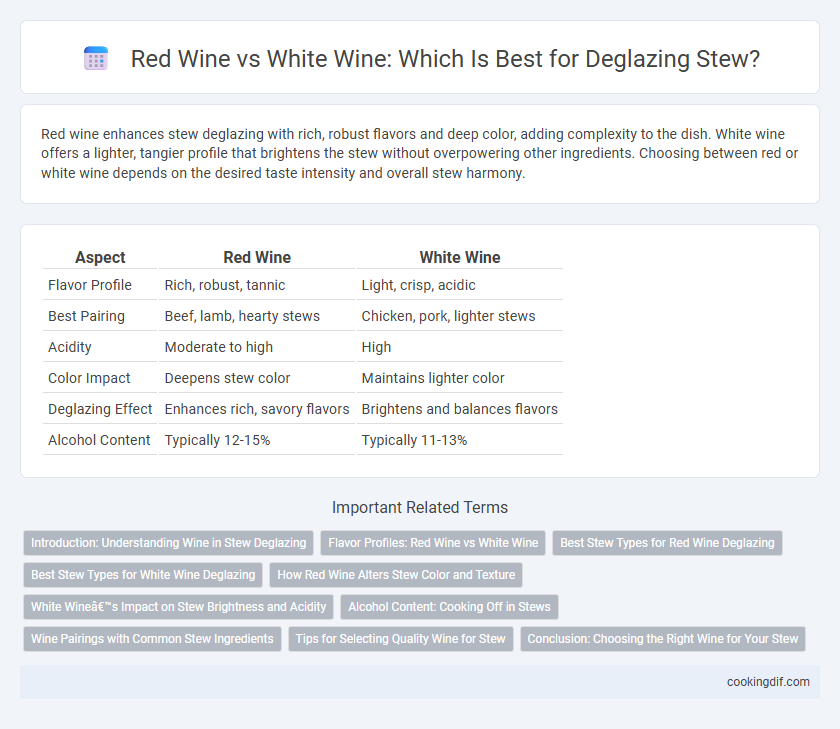Red wine enhances stew deglazing with rich, robust flavors and deep color, adding complexity to the dish. White wine offers a lighter, tangier profile that brightens the stew without overpowering other ingredients. Choosing between red or white wine depends on the desired taste intensity and overall stew harmony.
Table of Comparison
| Aspect | Red Wine | White Wine |
|---|---|---|
| Flavor Profile | Rich, robust, tannic | Light, crisp, acidic |
| Best Pairing | Beef, lamb, hearty stews | Chicken, pork, lighter stews |
| Acidity | Moderate to high | High |
| Color Impact | Deepens stew color | Maintains lighter color |
| Deglazing Effect | Enhances rich, savory flavors | Brightens and balances flavors |
| Alcohol Content | Typically 12-15% | Typically 11-13% |
Introduction: Understanding Wine in Stew Deglazing
Red wine offers rich tannins and robust flavors that enhance the depth and complexity of stews during deglazing, creating a savory, full-bodied base. White wine provides a lighter, more acidic profile that brightens the dish and preserves delicate aromas without overpowering the stew's ingredients. Selecting the right wine depends on the stew's primary components, with red complementing hearty meats and white elevating poultry or seafood-based recipes.
Flavor Profiles: Red Wine vs White Wine
Red wine enhances stew with rich, robust flavors and deep tannins that complement red meats, adding complexity and a slightly fruity, earthy note. White wine imparts a lighter, brighter acidity with subtle citrus and floral hints, which tenderizes ingredients without overpowering delicate flavors. Choosing between red and white wine for stew deglazing depends on the desired taste intensity and the main protein in the recipe.
Best Stew Types for Red Wine Deglazing
Red wine deglazing enhances the rich, robust flavors in beef, lamb, and venison stews by adding depth and a slightly fruity acidity that complements the meat. These types of stews benefit from the tannins and bold profile of red wine, which balances the hearty ingredients and intensifies the savory sauce reduction. Using varieties like Cabernet Sauvignon or Merlot optimizes the caramelized fond, creating a luxurious, well-rounded stew.
Best Stew Types for White Wine Deglazing
White wine is ideal for deglazing stews with lighter proteins such as chicken, turkey, or seafood, as its crisp acidity enhances delicate flavors without overpowering them. Varietals like Sauvignon Blanc or Pinot Grigio provide bright citrus and herbaceous notes that complement vegetable-based stews or those featuring creamy sauces. Using white wine for deglazing preserves the stew's freshness while lifting caramelized bits off the pan, intensifying overall flavor complexity.
How Red Wine Alters Stew Color and Texture
Red wine significantly deepens the color of stew, imparting a rich, ruby hue that enhances visual appeal. Its higher tannin content contributes to a thicker, more robust texture by breaking down connective tissues in meats more effectively than white wine. The complex phenolic compounds in red wine also intensify the stew's flavor profile, creating a fuller-bodied, more savory experience.
White Wine’s Impact on Stew Brightness and Acidity
White wine enhances stew brightness and acidity by imparting crisp, fruity notes that balance rich, savory flavors. Its higher acidity compared to red wine helps tenderize meat and lift the overall flavor profile, creating a fresher, lighter finish. Choosing dry white wine varieties like Sauvignon Blanc or Chardonnay ensures optimal deglazing results and vibrant stew complexity.
Alcohol Content: Cooking Off in Stews
Red wine typically contains 12-15% alcohol, which gradually cooks off during stew simmering, enhancing flavor without overpowering. White wine usually has slightly lower alcohol content, around 11-14%, allowing a subtler deglazing impact while still melding well with lighter stew ingredients. Extended simmering for at least 30 minutes ensures most alcohol evaporates, leaving concentrated taste without harshness in both red and white wine-deglazed stews.
Wine Pairings with Common Stew Ingredients
Red wine, particularly a robust Cabernet Sauvignon or Merlot, complements hearty beef stew by enhancing rich, meaty flavors and intensifying the savory depth during deglazing. White wine varieties like Chardonnay or Sauvignon Blanc are better suited for lighter stews with chicken or vegetable bases, adding acidity that brightens the dish without overpowering delicate flavors. Matching wine acidity and body to stew ingredients ensures optimal flavor balance, with tannic reds aligning with red meats and crisp whites pairing well with poultry or root vegetables.
Tips for Selecting Quality Wine for Stew
Choosing the right wine for stew deglazing involves selecting bottles with balanced acidity and moderate tannins to enhance the dish's depth without overpowering it. Red wines like Pinot Noir and Merlot offer rich, fruity flavors ideal for beef or lamb stews, while white wines such as Sauvignon Blanc provide crispness that complements chicken or vegetable-based stews. Always opt for a quality bottle under $20 to ensure authenticity and flavor impact without excessive cost.
Conclusion: Choosing the Right Wine for Your Stew
Red wine enhances stew with robust, fruity flavors and rich tannins, ideal for beef or lamb dishes that need depth, while white wine offers a lighter, slightly acidic profile perfect for chicken or vegetable stews. The choice depends on the meat's intensity and the desired taste complexity, as red wine adds boldness and white wine maintains brightness. Selecting the right wine ensures a balanced deglaze that complements and elevates your stew's overall flavor.
Red wine vs white wine for stew deglazing Infographic

 cookingdif.com
cookingdif.com